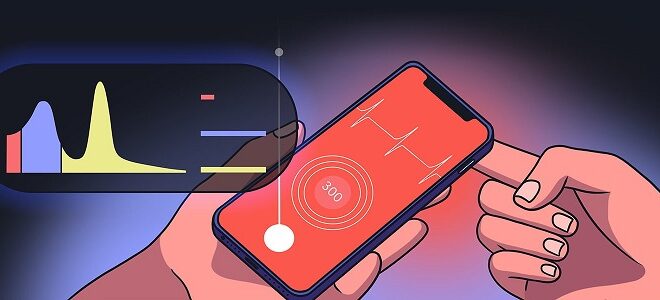Variability is a property of all biological processes associated with adapting the body to changing environmental conditions. Variability of specific parameters, including heart rate, reflects the influence of control signals that readjust cells, organs, or systems in the interests of maintaining homeostasis or adaptation to new conditions. Accordingly, heart rate variability, or HRV, reflects the cardiovascular system’s work and the body’s mechanisms of regulation.
Cardiovascular disease kills around 20 million people each year. Medical research and modern technology help to diagnose and record the illness in its early stages. Using a photoplethysmography to record blood flow with phone-camera flashes permits you to use a mobile phone to measure blood pressure and heart rate accurately.
This method allows you to understand the body’s response to various shots: from stress due to environmental circumstances to the body’s state before and after exercise in the gym. Photoplethysmography has become an effective alternative to home ECGs to assess heart rate, heart rate, and heart rate variability.
Of course, mobile applications do not give you a complete picture. But an in-depth analysis of personal heart rate using an accurate heart rate monitor or an HRV biofeedback app, based on the self-learning principles of artificial intelligence (AI), is effective not only for doctor’s diagnosis.
HRV: What Does it Say?
HRV indicators reflect vital indicators of management of an organism’s physiological functions – vegetative balance and its control mechanisms’ functional reserves. Analyzing HRV, we can assess the body’s active state and monitor its dynamics, up to pathological conditions with a sharp decrease in HRV and a high probability of death.
Studies suggest that a decrease in HRV directly indicates a violation of cardiac activity’s autonomic control, which gives an unfavorable prognosis. The highest rates of HRV are registered in healthy young people, athletes, and intermediate – in patients with various organic heart diseases, including ventricular arrhythmias, the lowest – in people who have had episodes of ventricular fibrillation.
The cardiovascular system is a remarkable example of a unique management system built on a hierarchical principle, where each lower-level functions typically autonomously. At changes of the external environment and the development of a pathological process to preserve homeostasis, higher levels are activated.
The process of adaptation requires the expenditure of information, energy, and metabolic resources of the body. Resource management depends on the external environment’s requirements and is carried out through nervous, endocrine, humoral mechanisms, split into autonomous and central.
Currently, traditional and classical is the idea of HRV as a method of studying the autonomic balance, the study of the interaction of the sympathetic and parasympathetic divisions of the autonomic nervous system.
Stress
Stress by nature is:
– physiological, which is caused by excessive exercise;
– psychological, due to complex relationships with the environment;
– information – generated by the redundancy, insufficiency, or inconsistency of vital information;
– managerial – due to the great responsibility for the decisions made;
– emotional, which is manifested in situations of threat or danger.
Stress can be:
– acute or shock, which is caused by various extreme situations;
– chronic, involving the presence of constant significant physical and moral stress on the person;
– psychosocial.
Acute stress develops instantly with the obligatory inclusion of the nervous, sympathetic-adrenaline, cardiovascular and pituitary-adrenal cortex systems. In the first minutes of acute stress, its main manifestations are registered, which affect the nervous and cardiovascular systems. Therefore, a diagram of heart rate variability will undoubtedly reflect your condition.
Chronic stress occurs with prolonged or repeated interaction of both strong and relatively weak stressors.
Various factors determine the nature of the stress response that leads to adaptation and illness:
– positive;
– negative;
– constructive;
– destructive.
With the Welltory app, you will learn to distinguish between stress types and their impact on your body.
HRV and Heart Disease
In patients with diseases of the cardiovascular system, the degree of deterioration of HRV parameters is closely related to the pathological process stage. Patients with myocardial infarction and chronic heart failure (CHF) develop “vegetative denervation” of the heart.
The decrease in HRV in patients with myocardial infarction is expressed in the deterioration of the temporal analysis, i.e., a reduction in SDNN, SDANN. The characteristics of spectral analysis also change:
- A reduction in high-frequency.
- An increase in the spectrum’s low-frequency components with a corresponding change in their ratio.
Doctors noted the disappearance of differences between day and night variability of intervals R-R at such patients.
Scientists are not sure whether reduced HRV is part of the mechanism responsible for increasing postinfarction mortality or simply an unfavorable indicator. Evidence suggests that decreased HRV is not a simple reflection of increased sympathetic or decreased vagal tone due to decreased ventricular contractility. Heart rate variability also characterizes decreased vagal activity, closely related to ventricular arrhythmias’ pathogenesis and sudden cardiac death. Most scientists consider low HRV as an independent factor in predicting increased risks to human life.
Regular Analysis
The prognostic significance of HRV itself is pretty moderate. Combining other techniques becomes even more significant in the clinically meaningful range of sensitivity (25-75%) to cardiac mortality and arrhythmias. It was reported that the positive prognostic significance is increased due to the combination of HRV with mean heart rate, left ventricular ejection fraction, frequency of ectopic ventricular activity with high-precision ECG parameters, and clinical examination data.
Modern man is inseparable from the mobile phone. Then why not use it even more efficiently. Regular measurements of health at home with a phone camera will help monitor the condition of the body. The Welltory application mentioned earlier uses the most extensive database, adjusts to your rhythm of life, and regularly analyzes your body’s biological response to warn you in time about the dangers and the need to seek medical help.
 HammBurg Be informed with latest news, reviews, entertainment, lifestyle tips, and much more.
HammBurg Be informed with latest news, reviews, entertainment, lifestyle tips, and much more.




